The U.S. Environmental Protection Agency (EPA) plans to cancel $7 billion in solar energy grants, according to official sources. These grants were given to states, tribes, and nonprofits through the Solar for All program. This program, made possible by the Inflation Reduction Act (IRA), helps low- and moderate-income families access clean energy. It supports rooftop and community solar installations.
The EPA said it is preparing formal notices to 60 recipients, informing them that their contracts may be revoked. The “Solar for All” program aimed to help solar installations in communities that have been underserved.
Many grant recipients had signed contracts and started their projects when the EPA froze the funds earlier this year. Now, these organizations worry about getting the support they were promised.
The move is part of the Trump administration’s effort to rethink or cancel some climate programs set up during Biden’s presidency. According to officials, the EPA is reviewing whether the “Solar for All” grants were issued in compliance with federal rules. Still, critics warn this change might hurt clean energy growth and access in struggling areas.
Sunset Before Sunrise: Projects Stalled Midway
Before the freeze, the Solar for All program was expected to help install solar systems for up to 900,000 households. The grants aimed to lower electricity bills for families by up to 20%. They also sought to boost energy reliability and create jobs in clean energy.
Some grant recipients, like tribal governments, state energy offices, and local nonprofits, started using the funds. They hired workers, planned construction, and designed outreach programs. These early actions relied on signed contracts, meaning many projects had legal and financial commitments.
With the EPA’s proposed cancellation, these efforts may now be on hold or completely abandoned. Community groups say some residents who signed up for solar panels are unsure about their installation status. Others say job training programs funded by the grants may lose momentum just as they were gaining interest.
Nonprofit legal groups and state attorneys general are looking into legal action to stop the cancellation. Some say that stopping the grants might break the Administrative Procedure Act. They believe this could also mess with the separation of powers in the U.S. Constitution, since the grants were part of an approved federal budget.
Boom Meets Policy Headwinds: Can Solar Keep Rising?
The U.S. solar industry remains one of the fastest-growing parts of the energy sector. In early 2025, the country added 10.8 gigawatts (GW) of new solar capacity—the fourth-highest quarterly total ever recorded.
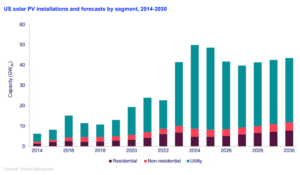
Moreover, solar makes up about two-thirds of all new power generation capacity in the United States. Solar projects are on the rise. California, Texas, and New York are leading in residential, commercial, and utility-scale installations.
However, experts warn that policy reversals like the EPA’s could harm this momentum. Community solar, especially in low-income areas, depends on public funding and federal incentives to thrive. Without grants like Solar for All, many developers may choose not to build projects in these areas due to cost and risk.
A report from the Solar Energy Industries Association (SEIA) found that solar deployment might drop 23% below expected growth by 2030. This could happen if tax credits and clean energy programs are removed.
- This includes the risk of losing up to 54 GW of planned capacity, affecting both grid reliability and job creation.
As demand for electricity rises due to data centers, electric vehicles, and AI, losing clean energy growth may lead to more reliance on fossil fuels.
Equity in the Dark: Who Loses When Solar Stops?
The Solar for All initiative was created not just to promote clean energy, but also to reduce energy poverty. Many of the households targeted by the program pay a large share of their income on electricity.
Solar power can lower bills and also offer backup power during emergencies. Plus, it improves indoor air quality by cutting down on gas appliances.
The program also supported energy justice goals by prioritizing tribal communities, rural areas, and urban neighborhoods most affected by pollution. It aimed to support battery storage, job training centers, and workforce programs. This would focus on areas with high unemployment or limited clean energy projects.
Canceling the program could increase the energy gap. Wealthy communities can afford rooftop solar, but many others cannot. It could also slow down organizations that were finally making progress after years of struggling to fund small clean energy projects.
What Comes Next for Clean Energy Grants?
At the time of this writing, the EPA has not yet finalized the cancellations, but plans to do so in the coming weeks. In the meantime, legal challenges are expected to move through the courts. Some judges have blocked parts of the climate funding freeze. More rulings may decide if the Solar for All grants should be honored.
The U.S. solar industry is still strong. However, changes in federal funding policies may impact where and how quickly future projects happen. Developers might move to larger commercial and utility-scale projects in more profitable areas. This shift could neglect the community solar market, which programs like Solar for All have supported.
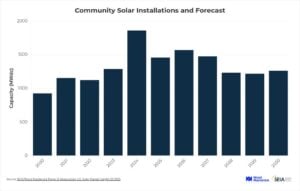
In 2024, the U.S. community solar market added 1.745 GWdc, the largest-ever annual total—a 35% increase over 2023. Growth was led by states like New York, Maine, and Illinois, with New York adding 861 MWdc, up 66% year-over-year.
However, the Q2 2025 SEIA/Wood Mackenzie report predicts a 22% drop in community solar installations for 2025. This decline is due to policy uncertainty and backlog issues. Still, the longer-term outlook is cautious yet hopeful.
Despite the setback, many local groups and clean energy advocates like Powerbank (formerly Solarbank) remain committed to expanding access. They hope funding will come back. If not, they want state incentives or private financing to help fill the gap. Still, the EPA’s decision marks a key moment for federal support of clean energy in low-income communities.
The EPA’s proposed cancellation of $7 billion in solar grants highlights the tension between climate goals and political shifts. While the solar market is growing, policy uncertainty creates risks. This is especially true for low-income households that need government help to access clean energy.
The courts may either allow the grants to move forward or uphold the cancellation. This shows that clean energy success relies heavily on stable policies, clear laws, and long-term commitment.
The post U.S. EPA Plans to Cancel $7 Billion in Solar Grants: What It Means for Solar Industry appeared first on Carbon Credits.
Carbon Footprint
Tesla Robotaxi Secures Permit in Texas, Fuels TSLA Stock Surge and Market Buzz
Featured image sourced from Tesla Robotaxi
Tesla has cleared a major hurdle in its push toward fully autonomous transportation. As per reports, the Texas Department of Licensing and Regulation (TDLR) has granted Tesla Robotaxi LLC a permit to operate as a transportation network company (TNC) across the state.
This green light allows the electric vehicle giant to roll out its ride-hailing service, both with and without human safety drivers. It marks its boldest step yet into the competitive robotaxi market.
The permit, issued this week, remains valid until August 6, 2026, setting the stage for Tesla to expand beyond its current limited service in Austin and directly challenge rivals like Uber, Lyft, and Waymo.
A Big Win for Tesla’s Autonomous Ride-Hailing Battle
Tesla’s latest permit authorizes the company to legally deploy fully driverless vehicles across Texas without a safety driver in the car, aligning perfectly with Elon Musk’s long-standing vision of a driverless future.
The company has been operating a pilot program in Austin since June 22, 2025, offering rides to a select group of influencers and industry analysts. These early riders, many of them active Tesla promoters on platforms like X and YouTube, have been experiencing trips in Model Y vehicles equipped with Tesla’s newest partially automated driving systems.
Although the cars currently run with a “valet” sitting in the passenger seat to step in during emergencies, they are also monitored remotely by Tesla’s operations center staff. With the new permit, Tesla now has the legal right to remove that in-person safety presence altogether.

Going Statewide: From Austin to All of Texas
Until now, Tesla’s robotaxi program was limited to small-scale trials in Austin. The TDLR permit changes that entirely, giving Tesla permission to operate anywhere in Texas. That includes bustling urban centers like Dallas and Houston, where demand for ride-hailing is strong.
More importantly, the permit gives Tesla the ability to expand rapidly—something Musk has hinted at repeatedly. On a recent earnings call, he predicted Tesla could serve half of the U.S. population with robotaxi services by the end of 2025.
The approval also places Tesla in a direct turf war with Waymo, Google’s self-driving unit, which already operates a robotaxi fleet in Austin through a partnership with Uber.
First Steps into Driverless Service
Tesla’s push into Texas marks the first time the company has deployed autonomous vehicles with paying passengers. This milestone puts it ahead of many automakers still in the testing phase.
In a surprise twist, just days after securing the Texas license, Tesla was spotted testing its robotaxi in Miami without any safety driver at all. While that was outside the Texas jurisdiction, it hints at Tesla’s national ambitions and confidence in its self-driving system.
Why Texas Matters for Tesla
Texas is a proving ground for Tesla’s robotaxi. The state has generally been friendly to autonomous vehicle testing and has clear legal frameworks that support driverless deployment.
By securing the TDLR permit, the company gains the freedom to launch fully driverless services statewide, scale operations without the legal hurdle of keeping human supervisors in every vehicle, and position itself as a first mover ahead of competing EV makers and robotaxi operators.
If successful, Texas could become the blueprint for Tesla’s expansion into other large, car-dependent states.
TSLA Stock Jumps on Robotaxi Momentum
Investor excitement has been quick to follow Tesla’s progress. After Elon Musk confirmed that Austin’s robotaxi service will open to the general public next month, TSLA shares surged more than 5%, closing at $346.50.
This rally reflects investor belief that robotaxi services could become a major revenue stream for Tesla, complementing its core EV sales. Analysts say the Texas approval strengthens Tesla’s first-mover advantage in the driverless ride-hailing market and could accelerate its push toward Musk’s ambitious target of serving half of the U.S. population by the end of 2025.
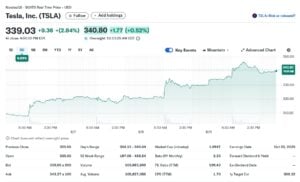
While the vision is ambitious, Tesla’s autonomous program hasn’t been without criticism. Early trial data in Austin shows around one notable system failure per vehicle every 2–8 days, equivalent to roughly 0.314 failures per day per car.
Videos posted online have captured incidents of Tesla’s robotaxis running stop signs, drifting into the wrong lanes, and failing to detect oncoming trains. The BBC highlighted that these issues have caught the attention of NHTSA, which confirmed it is in contact with Tesla to gather more information.
Early Performance and Safety Concerns
The NHTSA investigation adds to growing regulatory pressure. Reports suggest that Tesla has withheld certain incident data from public release, raising concerns about transparency in its robotaxi program.
Tesla’s self-driving systems face mounting scrutiny as new crash data raises safety concerns.
-
51 deaths since October 2024, including 2 linked to Full Self-Driving
-
Highest US crash rate in 2024: 26.67 accidents per 1,000 drivers — up 13.3% from 2023
-
Autopilot safety gap: 1 crash every 7.44 million miles on Autopilot vs. every 1.51 million miles without, as per Tesla’s Q1 2025 Vehicle Safety Report.
Statistically, Tesla currently has the highest crash rate of any U.S. automaker in 2024. Critics point out that while Musk often cites safety metrics favorable to Tesla, independent experts argue the data lacks consistent, third-party validation.
Musk’s Optimism vs. Robotaxi Reality
Elon Musk describes himself as “pathologically optimistic”, and his track record of bold promises supports that claim. Predicting that Tesla could cover half of the U.S. with robotaxi services within months is no small statement.
For now, Tesla’s Texas permit officially marks its entry into the state’s ride-hailing market. It puts the company in direct competition with Waymo, and brings Musk’s vision of a driverless future closer to reality.

However, Tesla still faces challenges. Experts are saying that it must improve safety, address regulatory concerns, and convince riders that its vision-only self-driving is as safe or safer than competitors using more sensors.
If Tesla succeeds, Texas could become the launchpad for a nationwide rollout, changing urban transportation and ride-hailing economics.
The post Tesla Robotaxi Secures Permit in Texas, Fuels TSLA Stock Surge and Market Buzz appeared first on Carbon Credits.
Carbon Footprint
BBVA Hits €30 Billion in Q2 for Sustainable Finance
Spanish banking firm Banco Bilbao Vizcaya Argentaria, aka BBVA, has set a new pace in sustainable finance. The bank recently announced that it has mobilized €30 billion ($32.5 billion) in green and social projects in Q2 2025 — its highest quarterly result ever. This brought its total for the first half of the year to €63 billion ($68.5 billion), marking a sharp 48% jump from the same period in 2024.
From Climate Action to Social Impact: BBVA’s €63 Billion Green Push
The growth pushes BBVA closer to its new target: channeling €700 billion ($760 billion) into sustainable financing between 2025 and 2029. The bank had already met its earlier €300 billion goal for 2018–2025 a year ahead of schedule, hitting the milestone in December 2024.
Of the €63 billion mobilized in H1 2025, 76% went toward climate change and natural capital projects. These covered areas such as renewable energy, efficient water use, sustainable agriculture, biodiversity protection, and the circular economy.
The remaining 24% went to social projects, including infrastructure for education and healthcare, entrepreneurship support, funding for small businesses, and financial inclusion for underserved communities.
Record Growth Across Business Segments
BBVA’s momentum came from strong growth in all business lines:
-
Commercial Banking: Mobilized €23.6 billion, up 53% year-on-year. Natural capital financing totaled €2.34 billion, with Mexico’s agricultural sector contributing half of that.
-
Corporate and Investment Banking (CIB): Contributed €31.9 billion, up 34%. The bank financed clean technologies, renewable projects, and sustainable supply chain solutions such as reverse factoring with green criteria. Renewable energy project funding alone reached €1.6 billion.
-
Retail Banking: Channeled €7.5 billion, up 119%. This included €742 million for hybrid and electric vehicle financing and digital tools that help customers measure potential energy savings.
Backing Breakthrough Clean Energy Projects
BBVA’s sustainability push isn’t just about volume — it’s also about innovation. In Q2 2025, the bank sponsored the Energy Tech Summit in Bilbao, attracting over 1,500 cleantech experts from 40+ countries.
There, it announced a landmark project finance deal — the first in the Iberian Peninsula for a hydrogen plant powered entirely by renewable energy. Scheduled to begin operations in H1 2026, the plant will be a key step in decarbonizing heavy industry.
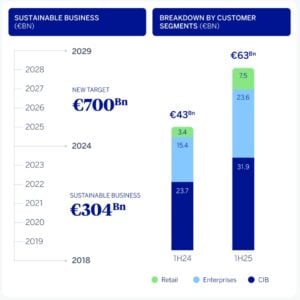
A More Ambitious €700 Billion Target
BBVA’s expanded goal more than doubles its previous plan, with a shorter deadline. The aim is to channel €700 billion in sustainable finance from 2025 to 2029, compared to the earlier €300 billion over eight years.
The strategy focuses on three pillars:
-
Climate Action – Funding renewable energy, clean technologies, and emissions reduction.
-
Natural Capital – Supporting agriculture, water conservation, biodiversity, and land restoration.
-
Social Opportunities – Financing healthcare, education, affordable housing, and entrepreneurship.
Driving the Net Zero Transition
Alongside its financing efforts, BBVA is working toward Net Zero emissions by 2050. It has already set interim 2030 decarbonization targets for ten sectors, including oil and gas, power generation, automotive, steel, cement, coal, aviation, shipping, aluminum, and real estate.
The bank is now preparing sector targets for agriculture — a major source of global emissions — as part of its broader climate plan.
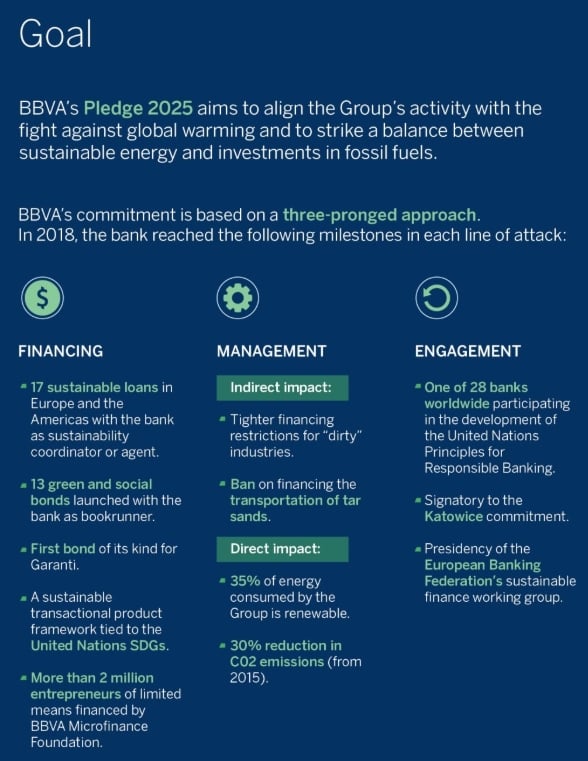
Why This €30 Billion Surge Matters
BBVA’s record-breaking quarter shows that sustainable finance is moving into the mainstream. The bank’s retail segment — up 119% — proves that demand for eco-friendly banking isn’t limited to corporations. Everyday, customers are increasingly choosing green loans, energy-saving solutions, and sustainable investment options.
These projects deliver dual benefits: reducing carbon footprints while improving social well-being. From renewable power plants to inclusive financing for small businesses, BBVA is aligning its growth with global sustainability goals.
How BBVA Plans to Hit the €700 Billion Mark
The bank’s roadmap includes expanding partnerships, scaling retail offerings, and enhancing digital sustainability tools. These platforms help clients understand the environmental impact of their investments, building transparency and trust.
For example, customers can estimate energy savings from home upgrades or track CO2 reductions from EV financing. By merging finance with real-time environmental insights, BBVA is turning sustainability into an accessible, measurable choice for more people.
Environmental and Carbon Benefits of These Investments
With 76% of funding directed to environmental projects in H1 2025, BBVA is investing heavily in emissions reduction, renewable energy, and ecosystem restoration.
Key highlights include:
-
Hydrogen & Renewables – €1.6 billion for renewable power and financing Iberia’s first renewable hydrogen plant.
-
Natural Capital – €2.34 billion for water conservation, sustainable agriculture, and biodiversity protection.
-
EV Transition – €742 million in hybrid and electric vehicle loans, cutting transport-related CO2.
These initiatives help replace fossil fuels, store carbon in healthier ecosystems, and encourage sustainable consumer behavior.
The Global Trend Fueling BBVA’s Growth
BBVA’s performance mirrors a global boom in sustainable finance. Green bond issuance could surpass €1 trillion annually by the end of 2025. Over 70% of large corporations now follow ESG strategies, driven by customer demand and regulatory pressure.
By beating its 2018–2025 target ahead of schedule and setting a new, more ambitious goal, BBVA is positioning itself among the leaders in climate-aligned banking. Its mix of green and social investments also supports the UN Sustainable Development Goals (SDGs).
Notably, its sustainability push comes with solid financial backing. The bank reported €5.45 billion in profit for H1 2025 and maintains strong capital reserves. Its “capital-light” growth model balances risk and return, keeping investors confident while pursuing long-term environmental impact.
What’s Next for Banking and Sustainability
The rise of ESG investing signals a shift in the role of banks. Customers, investors, and governments now expect institutions to be active players in the climate transition. BBVA’s quick pivot demonstrates its readiness to meet this demand at scale.
Going forward, expect more banks to adopt:
-
Clear Targets – Time-bound climate and social finance goals.
-
Transparency Tools – Digital platforms that track impact.
-
Innovation Financing – Support for emerging decarbonization technologies.
BBVA’s Role in Shaping the Future
From clean hydrogen plants to small business inclusion programs, BBVA’s sustainable finance strategy blends profitability with purpose. The bank is proving that climate action and social impact can be growth drivers, not just compliance measures.
Its combination of technology, strong performance, and measurable impact makes it a leader in the green banking race. As industries decarbonize and regulations tighten, banks that move early, like BBVA, will set the standard for the financial sector’s role in building a sustainable future.
The post BBVA Hits €30 Billion in Q2 for Sustainable Finance appeared first on Carbon Credits.
Carbon Footprint
Meta’s AI Forest Map: The Game-Changer for Carbon Tracking
Forests are vital for our planet. They help fight climate change by absorbing a lot of carbon dioxide from the air, acting as major carbon sinks. They store large amounts of carbon in biomass and soil, estimated to absorb about 30% of human-caused CO2 emissions annually worldwide.
However, scientists and project managers must track forest health. They need to know how much carbon forests store. This helps ensure that efforts to protect or grow forests are effective. This is called measuring, monitoring, reporting, and verifying forest carbon, often shortened to MMRV.
Eyes in the Sky: How Remote Sensing Sees Forests Differently
Measuring carbon in forests is tricky and expensive. Usually, people go out into the forest and measure trees by hand, which takes a lot of time and effort. It’s hard to do this over large areas, especially in dense or remote forests.
This is where remote sensing comes in.
Remote sensing is a way to gather information about forests without going there in person. It uses satellites, airplanes, or drones equipped with cameras and sensors. This technology can take pictures and collect data. It helps scientists learn how tall trees are, how dense the forest is, and how much carbon it might store.
There are different kinds of remote sensing data:
- Optical imagery: like normal photos taken from space or planes, showing the tops of trees and land features.
- Radar: which uses radio waves and can see through clouds and work at night.
- Lidar: which uses lasers to map the exact height and shape of trees in 3D.
The Challenge with Remote Sensing Data
Each data type has strengths and weaknesses. Optical images are good and widely available, but they can’t see through clouds and only show forest surfaces. Radar can see through clouds but has trouble measuring details in dense forests. Lidar is very accurate but expensive and covers less area.
To get the best info, scientists combine different types of data using artificial intelligence (AI) and machine learning techniques. Machine learning helps computers find patterns in huge amounts of data to make better estimates.
Meta’s Canopy Height Map: AI-Powered Forest Intelligence
Meta developed a unique AI model that merges high-resolution satellite images with lidar data. This model maps tree canopy heights globally with great detail—less than one meter per pixel. This means it can see individual trees in many places.
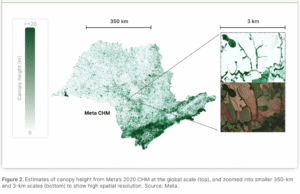
The map and the AI model are open-source and freely available, so anyone can use them to help forest projects. They enable better planning, monitoring, and verification of forest carbon projects. Reza Rastegar, Senior Manager of Research Science at Meta, stated:
“When applied thoughtfully, we believe AI research and remote-sensing tools, particularly those that are open source, have the potential to revolutionize the transparency and accessibility of the carbon market.”
Meta’s model has been validated with mean absolute errors of 2.8 meters in U.S. forests and 5.1 meters in Brazil. This reflects a promising improvement in estimating canopy height at fine scales. These advanced datasets and models are helping to track natural regeneration, selective logging, and forest degradation more accurately, which is vital for credible MMRV of carbon credits.
What’s special about this model?
- It works globally with very fine detail.
- It can help identify important areas to protect or restore.
- It can make new maps for different times if good images are available.
- It helps detect small changes in forests, like selective logging (cutting some trees but not all).
- It supports methods from carbon credit standards. This is important for those who need dynamic baselining or updating project baselines with real data from nature.
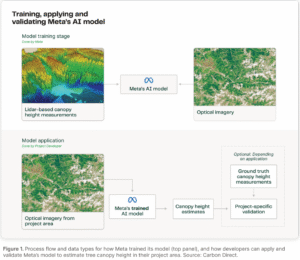
RELATED: Meta and Microsoft Secured Long-Term Carbon Credit Deals to Support Olympic Rainforest
From Pixels to Carbon Credits: Turning Data into Climate Action
Forest carbon projects use different official methods to create and verify forest carbon credits. The three main methods Meta focuses on are:
- Verra VM0045 – for improved forest management (IFM).
- Verra VM0047 – for afforestation, reforestation, and revegetation (ARR).
- American Carbon Registry (ACR) IFM – a US-based improved forest management method.
Here’s how Meta’s canopy height map and AI model fit into these methods:
- In project planning, the map helps find good parcels of forest to include, determine project boundaries, and understand forest structure.
- For dynamic baselining, especially in ARR and ACR’s IFM methods, the AI model can help update baselines based on real forest growth or loss over time.
- For reversals monitoring (tracking if carbon gains are lost, e.g., due to fire or logging), the map gives better details to detect forest disturbances.
The Fine Print: What Meta’s Model Gets Right—and Where It Struggles
Many traditional satellite products can’t reliably measure forest height or biomass in dense forests or small areas. Meta’s model, because it uses very high-resolution images, helps overcome this.
Monitoring small or fragmented forests, river corridors, or areas with selective logging is crucial. These places are difficult to track using low-resolution data.
Meta’s canopy height model is a powerful tool for estimating forest structure, but it comes with limitations. It works best with high-quality imagery at 0.5–1 meter resolution. The global canopy height map uses images from 2009 to 2020. This means it might not show current forest conditions. So, there’s a need for updated maps.
Accuracy may also drop in underrepresented forest types, so local validation with field or lidar data is advised. Using the model requires significant computing power and technical expertise, which may limit adoption.
For forest carbon projects, remote sensing offers great promise but faces barriers. There is no universal agreement among registries, buyers, and developers on acceptable methods or datasets.
In addition, technical skills, computational capacity, and access to affordable, high-quality datasets remain limited. Uncertainty around accuracy—and lack of consensus on acceptable error levels—make trust and comparability difficult.
For the identified barriers, the report authors recommend the following:
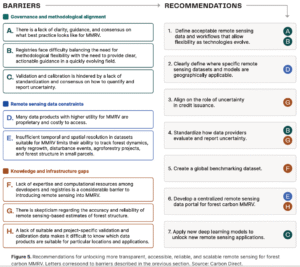
Closing the Gap Between Innovation and Impact
Experts want clearer standards for how datasets can be used. They also seek better reporting on uncertainty and clearer rules for issuing carbon credits. A global benchmarking database with verified data and a central portal for quality datasets could help boost adoption.
Moreover, easier AI tools would make this process smoother. Integrating advanced models like Meta’s into accessible platforms, alongside collaborative standard-setting, will be crucial to scaling reliable forest carbon monitoring and verification.
Examples of New and Exciting Uses of Meta’s Model
- Counting trees in agroforestry projects to monitor performance.
- Mapping old-growth forests and biodiversity hotspots.
- Detecting subtle forest degradation, like selective logging.
- Monitoring reversals (losses of carbon stored) with greater accuracy.
- Supporting more accurate estimates of above-ground biomass.
Forests are vital to fighting climate change by storing carbon, but measuring how much carbon they hold and how this changes over time is tough. New technologies like remote sensing are making this easier, faster, and cheaper.
Meta’s AI-powered canopy height map is a cutting-edge tool offering very detailed, global forest height data that can help in planning, monitoring, and verifying forest carbon projects.
The post Meta’s AI Forest Map: The Game-Changer for Carbon Tracking appeared first on Carbon Credits.
-
Climate Change2 years ago
Spanish-language misinformation on renewable energy spreads online, report shows
-
Climate Change Videos2 years ago
The toxic gas flares fuelling Nigeria’s climate change – BBC News
-

 Greenhouse Gases1 year ago
Greenhouse Gases1 year ago嘉宾来稿:满足中国增长的用电需求 光伏加储能“比新建煤电更实惠”
-

 Climate Change1 year ago
Climate Change1 year ago嘉宾来稿:满足中国增长的用电需求 光伏加储能“比新建煤电更实惠”
-

 Carbon Footprint1 year ago
Carbon Footprint1 year agoUS SEC’s Climate Disclosure Rules Spur Renewed Interest in Carbon Credits
-
Climate Change2 years ago
Why airlines are perfect targets for anti-greenwashing legal action
-
Climate Change Videos2 years ago
The toxic gas flares fuelling Nigeria’s climate change – BBC News
-
Climate Change2 years ago
Some firms unaware of England’s new single-use plastic ban





